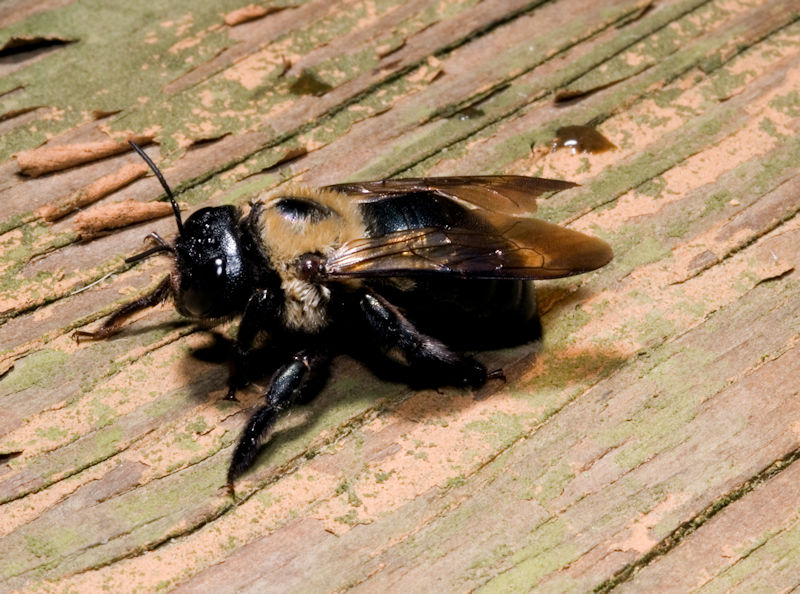When to Call for Professional Help with Carpenter Bees
Carpenter bees are valuable pollinators but can cause serious damage to wooden structures. Knowing when to call a professional pest control service can save homeowners in Southern Maryland and Northern Virginia from costly repairs and recurring infestations. Professionals bring expert knowledge, effective treatments, and preventative solutions to manage severe carpenter bee problems.
Signs of a Carpenter Bee Infestation
Recognizing the signs of a serious carpenter bee infestation early is crucial. Common indicators include:
- Large, round holes in wooden surfaces, often surrounded by sawdust (frass).
- Swarming bees near wood, particularly during spring and summer.
- Weakened wood caused by tunnels where bees lay their eggs.
If these signs are present, prompt action is essential to avoid further damage.
Why You Shouldn’t Ignore Carpenter Bee Damage
Ignoring an infestation can lead to:
- Structural damage: Bees bore tunnels that weaken wood over time.
- Costly repairs: Repeated infestations can compromise beams, siding, and decks.
- Attracting other pests: Unchecked infestations may bring additional insects into your home.
Taking early steps to address the problem can save significant repair costs and protect your property.
Professional Carpenter Bee Inspections
What Happens During an Inspection?
When you call a pest control professional, they will:
- Identify carpenter bee activity by locating entry holes and damage.
- Evaluate the infestation level and determine the extent of the problem.
- Create a treatment plan tailored to your home’s needs.
Tools and Techniques Used
Experts use advanced tools like moisture meters and inspection cameras to uncover hidden damage. This ensures all affected areas are properly treated and repaired.
Effective Professional Treatments for Carpenter Bees
Common Treatment Methods
Pest control professionals use proven techniques, including:
- Insecticidal dust: Applied inside tunnels to kill bees and prevent re-infestation.
- Wood treatments: Specialized coatings deter bees from boring into wood.
- Traps: High-grade traps capture bees to reduce their population safely.
Safety and Long-Term Benefits
Professional methods are safe for your family and pets while targeting carpenter bees effectively. Treatments also protect your wood from future infestations, reducing long-term risks.
Repairing Carpenter Bee Damage
Services Offered by Professionals
After eliminating the bees, pest control companies can:
- Fill tunnels to restore wood’s structural integrity.
- Replace severely damaged wood with treated lumber.
- Apply protective finishes to prevent new infestations.
Importance of Repairs
Sealing damaged areas not only improves your home’s appearance but also prevents bees from returning. Regular maintenance helps safeguard your investment.
How to Choose the Right Pest Control Service
Tips for Selecting a Reliable Company
When choosing a pest control service, look for:
- Positive reviews from satisfied customers.
- Licenses and insurance to ensure accountability.
- Experience with carpenter bees and other wood-damaging pests.
Questions to Ask
- What is your experience with carpenter bee infestations?
- Are your treatment methods safe for pets and the environment?
- Can you provide references or case studies?
Selecting a trustworthy provider ensures effective treatment and peace of mind.
FAQs About Carpenter Bee Infestations
Q: What are the signs of a carpenter bee infestation?
A: Look for round holes in wood, sawdust piles, and increased bee activity near wooden surfaces.
Q: Why hire a professional for carpenter bees?
A: Professionals have specialized tools and treatments to eliminate bees, repair damage, and prevent future infestations.
Q: What treatments do professionals use?
A: Methods include insecticidal dust, wood treatments, and traps to safely manage carpenter bees.
Q: How do I choose the right pest control company?
A: Choose a licensed, insured provider with positive reviews and proven experience handling carpenter bee issues.
Q: What happens during a professional inspection?
A: Experts inspect your property for signs of activity, assess damage, and create a detailed treatment plan.
Further Reading
NEED HELP?
If you live in Southern Maryland, or Northern Virginia
FIND YOUR SOLUTION HERE
People, Pet & Pollinator Safe! Pest control for people who care.
